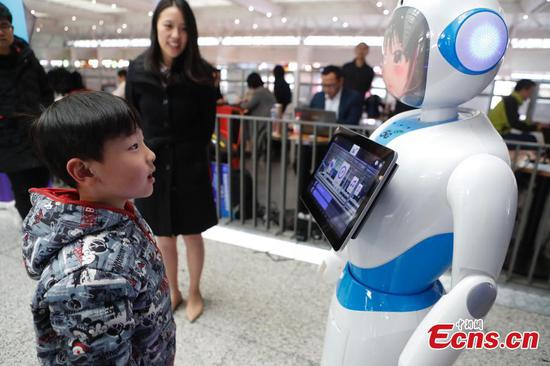
An engineer uses Honeywell's GoDirect connected maintenance system to monitor an airplane's safety conditions. (Photo provided to China Daily)
Airlines are using digital technologies to improve operating efficiency and safety. The results are smarter and safer aircraft, better flight experiences and lower operating costs.
"Digitalization opens a new horizon with regard to safety, efficiency and cost for both aircraft manufacturing and civil aviation sectors," Xu said.
For example, airlines can lower maintenance costs by predicting the health of aircraft equipment using big data, while passengers enjoy communications and entertainment in "connected aircraft".
With internet-based predictive maintenance technology, auxiliary power unit maintenance and malfunction data is downloaded from existing data on the aircraft. It allows for the prediction of imminent hardware malfunctions or other potential problems with a high degree of precision.
The data is then relayed to maintenance crews in an intuitive and visual manner, helping them tackle malfunctions before they occur. This allows for proactive and more efficient maintenance.
"An aircraft makes money for the airline only when it is flying, and revenue ceases as soon as it lands," Yu said.
If technicians can sense the aircraft's "health" by using data generated by it and carry out predictive maintenance, "it's a safer and more profitable operation", Yu said.
In fact, technicians can monitor and assess the health of an airplane while it is in the air by analyzing real-time data and selecting the appropriate time to carry out maintenance, repairs or replacement of parts.
In November 2018, the Commercial Aircraft Corp of China and e-commerce giant Alibaba Group jointly launched the Wang Jian Large Aircraft Workshop, an initiative to explore the use of intelligent manufacturing technology in passenger aircraft. COMAC is the developer of China's C919 large passenger airplane.
The workshop is one of several collaborations between China's internet giants and commercial aircraft manufacturers to inject technologies like the internet, big data, cloud-computing and artificial intelligence into aviation manufacturing.
The International Civil Aviation Organization has forecast that China will be the world's largest civil aviation market by mid-2020.
In 2018, China's civil aviation industry hit a new record with more than 10 million flights. Passenger numbers were up 10.9 percent year-on-year to 610 million and cargo was up 4.6 percent to 7.385 million metric tons, according to the CAAC.
China's civil aviation authorities are pushing forward the integration of the civil aviation sector with new technologies such as facial recognition, automatic vending and luggage check-in, and intelligent inquiry services.
The CAAC is also encouraging the application of artificial intelligence and biological feature recognition technologies in its security operations, and promoting in-flight connectivity.


















































